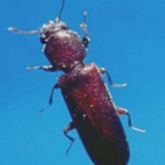Powderpost beetle

Adult powderpost beetle
© Queensland Government

Timber reduced to a fine flour-like powder by larvae of powderpost beetles
© Queensland Government
The powderpost beetle is one of the most significant timber borers found in Queensland. The larvae can reduce susceptible timber to a fine, flour-like powder.
The beetle attacks seasoned timber, causing significant structural damage and considerable financial loss. For property owners and manufacturers, prevention is less costly than treatment.
Scientific name
Other names
- Brown lyctus beetle
- Powderpost borer
- Lyctine borer
Similar species
- Lyctus discedens (the small powderpost beetle, up to 2mm in length)
- L. planicollis
- L. parallelocollis
- Tristaria grouvellei
- Minthea rugicollis (Malayan powderpost beetle, now established in Queensland due to presence in imported rainforest hardwoods from South-East Asia)
- Cigarette beetle (Lasioderma serricorne)
- Common furniture beetle (Anobium punctatum)
- Pine bark anobiid (Ernobius mollis)
- Queensland pine beetle (Calymmaderus incisus)
Description
- Adults are flat, up to 7mm long, dark brown and shiny.
- Adults have a distinct head and the terminal segments on the antennae appear clubbed.
- Larvae are cream-coloured with brown heads and jaws and 3 pairs of small jointed legs.
- Larvae, on hatching, are about 0.5mm long with a straight body. They become C-shaped after the first moult and grow up to 5mm in length.
- Small piles of smooth, flour-like powder may be seen outside the timber, although infestations may not be noticed until the adults emerge.
See additional images on the Pests and diseases image library (PaDIL).
Distribution
- Widespread in Queensland's tropical and subtropical climates
- Present worldwide
Hosts
- Sapwood of susceptible hardwood timbers (not softwoods) that contain enough starch to nourish the developing larvae and have sufficiently large pores or vessels for eggs to be deposited.
- Logs or sawn timbers with a moisture content of 8–30%.
- Susceptible timber species (as listed in AS 5604–2003 and on the Queensland Government timber properties information pages), including:
- kauri pine (Agathis robusta)
- spotted gums (Corymbia species)
- western white gum (Eucalyptus argophloia)
- narrow-leaved red ironbark (E. crebra)
- Dunn's white gum (E.dunnii)
- rose gum (E.grandis)
- tallowwood (E. microcorys)
- Sydney blue gum (E. saligna)
- European oak (Quercus species)
- kwila (Intsia bijugaI).
Damage
- Powderpost beetles excavate irregular galleries packed with fine flour-like powder.
- Infested timber may be reduced to powder within a shell of wood, perforated by exit holes 1–2mm in diameter.
- Damage may occur anywhere that susceptible timber has been used (such as in subfloor areas, in living space, in roof space, or in furniture and artefacts).
- Reinfestation is common for up to 5 years after tree felling, until the food resource is depleted.
- In new houses, exit holes may appear in the lining materials (for example in plasterboard and panelling) and joinery. These holes are made by adults emerging from the hardwood framing underneath.
Biology
- Female beetles lay up to 70 eggs in sapwood containing starch, which is essential for larval growth.
- Eggs hatch after 1–3 weeks, depending on temperature, and the larvae create tunnels in the wood as they feed.
- Larvae take 2–12 months to mature, depending on temperature, humidity and food supply.
- Fully grown larvae tunnel towards the surface and create oval cells in which they pupate.
- Mature beetles emerge after 2–3 weeks through circular holes (1–2mm diameter), creating small piles of fine flour-like powder on the timber surface.
- Beetles can mate and lay eggs within 24 hours of emergence. They typically live for 2–6 weeks.
- There may be 1 generation or more per year.
Control
- Avoid damage by removing sapwood from susceptible timber species or by using non-susceptible timber.
- Coating timber thoroughly on all surfaces with paint, varnish or wax will protect from powderpost beetles, unless infestation has already occurred. Take care not to leave any gaps where beetles may enter.
- Kiln drying will kill all stages of powderpost beetles; however, the beetle can reinfest susceptible timber when removed from the kiln.
- Boron and various chemical treatments are also available.
- Where damage is not structural, treatment may not be needed except to repair the timber's appearance.
Resources and research
- Australian Pesticides and Veterinary Medicines Authority (APVMA)
- Gay, FJ, 1953, Observations on the biology of Lyctus brunneus (Steph.), Australian Journal of Zoology, 1(1):102–110, viewed Aug 2023
- Peters, BC, Creffield, JW, Eldridge, RH, 2002, Lyctine (Coleoptera: Bostrichidae) pests of timber in Australia: a literature review and susceptibility testing protocol, Australian Forestry, 65(2):107–119, viewed Aug 2023